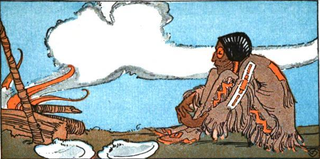Lakota mythology is the body of sacred stories that belong to the Lakota people, also known as the Teton Sioux.
In Lakota mythology, Iya is a storm-monster, brother of Iktomi the spider. He eats humans, animals and consumes villages to satisfy his otherwise endless appetite. He is in fact considered a demon in various traditions. The tornado, the snowstorm, the hurricane or the thunderstorm would all be considered manifestations of this deity. He travels with his storms in a tipi painted with magical symbols, and when he appears, he is often faceless and formless. His home is said to be under the waters, where he resides with his mother, Unk.

In Lakota mythology, Iktómi is a spider-trickster spirit, and a culture hero for the Lakota people. Alternate names for Iktómi include Ikto, Ictinike, Inktomi, Unktome, and Unktomi. These names are due to the differences in languages between different indigenous nations, as this spider deity was known throughout many of North America's tribes.
In Lakota mythology, Wi is one of the most powerful spirits. He is a solar spirit, and is associated with the American Bison. He is the father of Wóȟpe. Anog Ite attempted to seduce Wi, but she had one of her two faces changed into an ugly visage as punishment.
In Lakota mythology, Anúŋg Ité is a daughter of Škáŋ and wife of Tate. She was tricked by Iktómi to attempt to seduce Wi but failed when Škáŋ tells Wi that he has forgotten his wife. For attempting to undo the proper order and place herself in Hanwi's position and forgetting her own family, one of her two faces was made ugly as punishment. She was the mother of the Four Winds and Yum, the whirlwind. Because she was separated from her children, she causes pains to pregnant woman and makes babies cry. She was also said to have taught the Lakota how to separate porcupine quills and dye them.
In Lakota mythology, Unk Cekula is a serpentoid creature which was responsible for many unexplained disappearances and deaths. Her male counterpart is known as Unk Tehi.

Nanabozho, also known as Nanabush, is a spirit in Anishinaabe aadizookaan, particularly among the Ojibwe. Nanabozho figures prominently in their storytelling, including the story of the world's creation. Nanabozho is the Ojibwe trickster figure and culture hero.

The heyoka is a kind of sacred clown in the culture of the Sioux of the Great Plains of North America. The heyoka is a contrarian, jester, and satirist, who speaks, moves and reacts in an opposite fashion to the people around them. Only those having visions of the thunder beings of the west, the Wakíŋyaŋ, and who are recognized as such by the community, can take on the ceremonial role of the heyoka.
In Lakota mythology, Íŋyaŋ (Rock) was the first of the powerful spirits. He existed before the beginning. He then created Maka and gave it the spirit Makȟá-akáŋl, the second of the spirit beings and a part of Íŋyaŋ. After creating Makȟá, Íŋyaŋ was very weak. He created miniature versions of Makȟá, and her lover, father sky. Those miniatures were humans. This effort made Íŋyaŋ hard and powerless. His blood became the blue waters and the sky.
Deer Woman, sometimes known as the Deer Lady, is a spirit in Native American mythology whose associations and qualities vary, depending on situation and relationships. To women, children, and men who are respectful of women and children, she is associated with fertility and love. However, to those who have harmed women and children, she is vengeful and murderous, and known to lure these men to their deaths. She appears as either a beautiful young woman with deer feet or a deer.

The sky often has important religious significance. Many religions, both polytheistic and monotheistic, have deities associated with the sky.

In mythology and the study of folklore and religion, a trickster is a character in a story who exhibits a great degree of intellect or secret knowledge and uses it to play tricks or otherwise disobey normal rules and defy conventional behavior.
Coyote is an irresponsible and trouble-making character who is nevertheless one of the most important and revered characters in Navajo mythology. Even though Tó Neinilii is the Navajo god of rain, Coyote also has powers over rain. Coyote’s ceremonial name is Áłtsé hashké which means "first scolder". In Navajo tradition, Coyote appears in creation myths, teaching stories, and healing ceremonies.
Wocekiye is a Lakota language term meaning "to call on for aid," "to pray," and "to claim relationship with". It refers to a practice among Lakota people engaged in both the traditional Lakota religion as well as forms of Christianity.
Lakota religion or Lakota spirituality is the traditional Native American religion of the Lakota people. It is practiced primarily in the Lakota reservations of the North American Plains. The tradition has no formal leadership and displays much internal variation.




